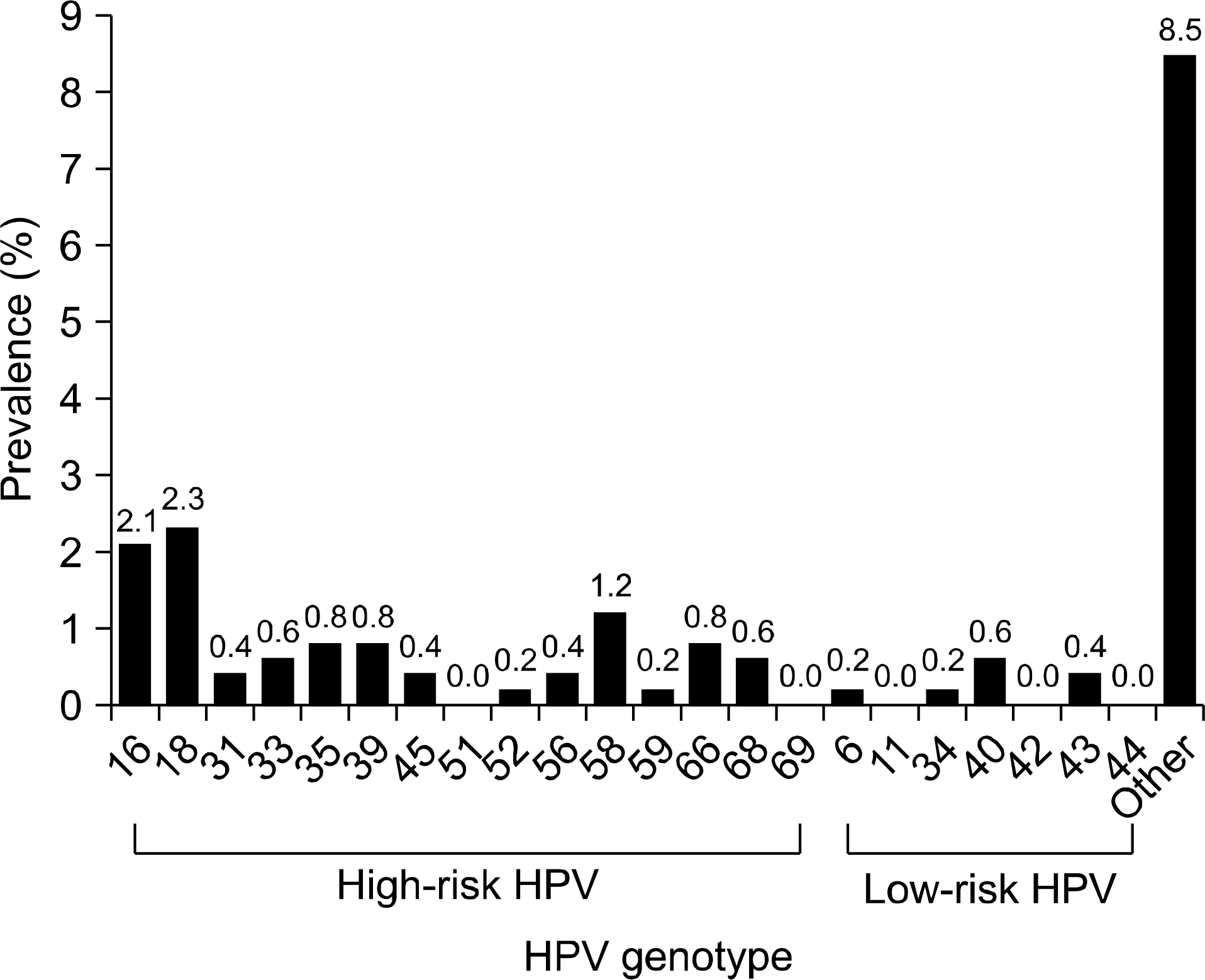초록
Background
Methods
Results
Conclusion
REFERENCES
Fig. 1.

Table 1.
The values are presented as number and percentage (%) in parentheses. *High-risk HPV genotype includes both single high-risk genotype infection and multiple genotype infection including any high-risk genotype. Abbreviations: HPV, human papilloma virus; ASCUS, atypical squamous cells of undetermined significance; LSIL, low-grade squamous intraepithelial lesion; HSIL, high-grade squamous intraepithelial lesion; PAP smear, papanicolaou smear.
Table 2.
| Normal (n=496) | ASCUS (n=11) | LSIL (n=7) | HSIL (n=4) | |
|---|---|---|---|---|
| HPV any | 78 (15.7) | 5 (45.5) | 4 (57.1) | 4 (100.0) |
| HPV-16 | 10 (2.0)* | 1 (9.1) | 0 (0.0) | 0 (0.0) |
| HPV-18 | 9 (1.8)* | 1 (9.1) | 1 (14.3) | 1 (25.0)* |
| HPV-31 | 1 (0.2) | 0 (0.0) | 0 (0.0) | 1 (25.0) |
| HPV-33 | 3 (0.6)* | 0 (0.0) | 0 (0.0) | 0 (0.0) |
| HPV-35 | 3 (0.6)* | 0 (0.0) | 0 (0.0) | 1 (25.0)* |
| HPV-39 | 3 (0.6)* | 0 (0.0) | 0 (0.0) | 1 (25.0)* |
| HPV-45 | 1 (0.2) | 1 (9.1) | 0 (0.0) | 0 (0.0) |
| HPV-52 | 1 (0.2) | 0 (0.0) | 0 (0.0) | 0 (0.0) |
| HPV-56 | 1 (0.2) | 0 (0.0) | 1 (14.3) | 0 (0.0) |
| HPV-58 | 4 (0.8)* | 0 (0.0) | 1 (14.3) | 1 (25.0) |
| HPV-59 | 1 (0.2) | 0 (0.0) | 0 (0.0) | 0 (0.0) |
| HPV-66 | 3 (0.6) | 0 (0.0) | 0 (0.0) | 1 (25.0)∗ |
| HPV-68 | 2 (0.4)∗ | 0 (0.0) | 0 (0.0) | 0 (0.0) |
| HPV-6 | 1 (0.2) | 0 (0.0) | 0 (0.0) | 0 (0.0) |
| HPV-34 | 1 (0.2) | 0 (0.0) | 0 (0.0) | 0 (0.0) |
| HPV-40 | 3 (0.6)* | 0 (0.0) | 0 (0.0) | 0 (0.0) |
| HPV-43 | 2 (0.4)* | 0 (0.0) | 0 (0.0) | 0 (0.0) |
| Other | 41 (8.3) | 2 (18.2) | 1 (14.3) | 0 (0.0) |
∗ * Total of 11 cases were known as multiple genotype infections (HPV-16, HPV-43 coinfection; HPV-16, HPV-35, and HPV-68 coinfection; HPV-16, HPV-39, HPV-58, HPV-66, HPV-40, and HPV-43 coinfection; HPV-18, HPV-33 coinfection; HPV-18, HPV-35 coinfection; HPV-18, HPV-39 coinfection; HPV-18, HPV-40 coinfection; HPV-18, HPV-58 coinfection; HPV-18, HPV-68 coinfection; HPV-35, HPV-58 coinfection; HPV-35, HPV-66 coinfection).




 PDF
PDF ePub
ePub Citation
Citation Print
Print


 XML Download
XML Download